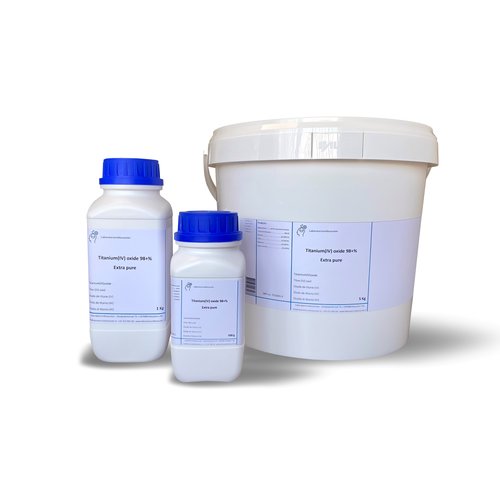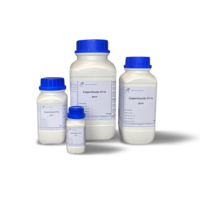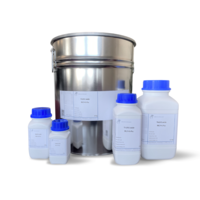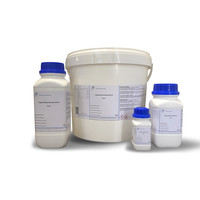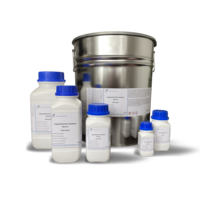You have no items in your shopping cart
Titanium(IV) oxide ≥98 %, extra pure
- Buy 2 and save 5%
- Buy 6 and save 10%
What is Titanium Oxide?
Titanium(IV) oxide (titanium dioxide) is the IV oxide of titanium. In addition to this polymorphic oxide, there are a number of non-stoichiometric suboxides of titanium, the so-called Magneli phases, as well as titanium(III) oxide and titanium(II) oxide.
Titanium dioxide has a wide variety of uses as a white pigment, which is why four to five million tons are produced worldwide each year. The main application areas are in the field of coatings such as lacquers and paints, followed by plastic coloring and laminate paper. Colored products usually also contain white pigments to achieve high hiding power.
Physical Characteristics
The melting point of titanium dioxide is 1855 ° C, the compound is thermally stable. Titanium dioxide is also chemically inert. It is lightfast, inexpensive and therefore an important white pigment.
Optical properties
The refractive index of titanium oxide is high and has a wide dispersion. The refractive index also depends significantly on the crystal modification. Titanium dioxide is birefringent.
From a coloristic point of view, titanium dioxide, due to its high refractive index, has the highest hiding power of all white pigments and at the same time excellent lightening power. The maximum covering power of titanium dioxide is approximately 200 nm to 300 nm, depending on the application and reference size, number or mass-related size distribution.
Titanium dioxide is a semiconductor, so the valence band is completely filled and the conduction band is not occupied at zero temperature. The band gap depends on the modification. Light quanta with an energy greater than the band gap are absorbed. UV light can also be absorbed at the correct wavelength, providing UV protection. Short-wave light radiation lifts electrons from the valence band to the conduction band, leaving a hole. The size of the band gap depends on the crystal direction and, in the field of nanoparticles, on the particle size.
What is Titanium Oxide used for?
pigment
Titanium dioxide has a refractive index significantly higher than that of most organic materials used to bind colors. This means that pigments made from titanium oxide scatter light effectively, resulting in a well-covering white color. The optimal size of the pigments is in the range from 200 nm to 300 nm. The size range is the result of the Mie theory. The particle size affects the opacity on the one hand and the color tone on the other; finely divided pigments appear more bluish. With a market share of approximately 60%, the most important applications are coating materials and 25% polymer applications.
Pure titanium dioxide is rarely used, because light-induced chemical radical reactions take place in addition to the UV-protective effect of the TiO2. Functionalization of the pigment granules reduces this effect and at the same time improves the color properties, mostly through easier dispersion. Some applications, e.g. B. use anatase pigments for fiber or cement applications despite the higher photochemical activity, while most applications fall back on rutile pigments.
Photocatalyst
Many manufacturers offer TiO2 based photocatalysts. These are usually anatase, anatase-rutile mixtures or doped titanium dioxides with a wide range of possible applications. Photocatalysis is a heterogeneous catalysis in which gaseous or dissolved substances react under UV light by radical reaction or transfer of charge carriers to titanium dioxide or other substances. Illumination with UV light, the energy of which is greater than the bandgap, or the less efficient excitation from the impurities of a dopant generates free charge carriers, electrons in the conduction band and holes in the valence band. These pairs of charge carriers usually recombine very quickly, but the bending of the band in the area of the surface can lead to separation of charge carriers. These usually react with adsorbed oxygen and water to form hydroxyl and peroxy radicals. Except in the case of direct charge transfer to adsorbates, the radicals generally react with adsorbed organic substances. The reaction pathways to complete mineralization can be very complex and require many photon excitations.
For outdoor use, an example of which is photocatalytic self-cleaning, the UV component of sunlight ASTM 1.5 of about 3% is generally used, with a maximum of about 35 W/m2. Indoor applications are usually less favourable, on the one hand the UV component is very low or the reaction rate is low in the case of doped catalysts. The parameters in photocatalysis are differently defined quantum yields. Typical values can hardly be given, since a large number of parameters enter the catalysis. Orders of magnitude of 1 reaction per 1000 photons are usually quoted. Another problem is that the photocatalytic reactions do not distinguish between the organic binder matrix and the pollutants. Unsuitable binder systems therefore tend to chalk early.
Other uses
In the manufacture of special optical glasses, TiO2 is used to influence the optical dispersion, the Abbe number. Titanium dioxide in the anatase modification is the main component of the catalysts used for the industrial denitrification of flue gases using the SCR process. The dye solar cell (Grätzel cell) is based on the semiconductor properties of titanium dioxide. Memristors were made using titanium dioxide. Titanium dioxide is also used as the main component of the ceramic dielectric in class 1 ceramic capacitors. Synthetic rutile single crystals are used for optical prisms or as diamond imitations for their optical properties. The birefringence makes the imitations easy to spot. In addition, titanium dioxide is used to produce test aerosols.
Technical properties
Molar mass (M) 79,90 g/mol
Density (D) 4,26 g/cm³
Boiling point (bp) 3000 °C
Melting point (mp) 1843 °C
CAS No. [13463-67-7]
EG-Nr. 236-675-5
Downloads

